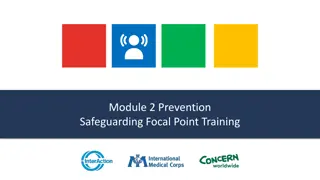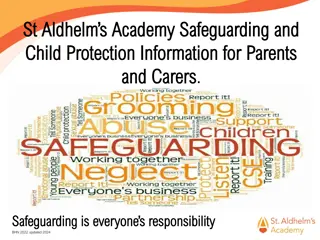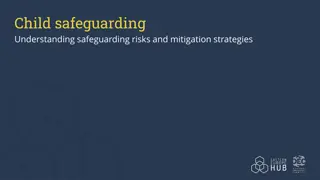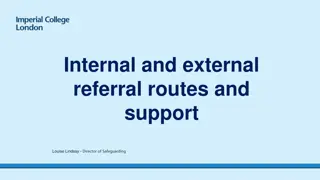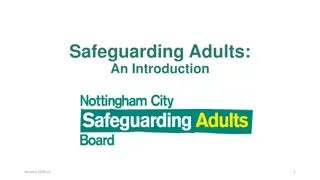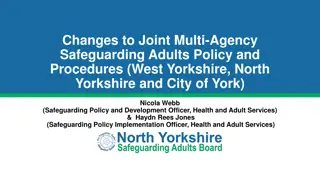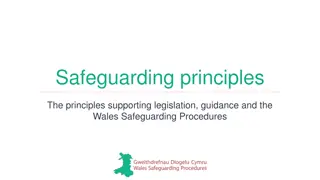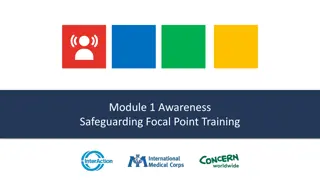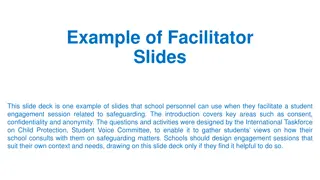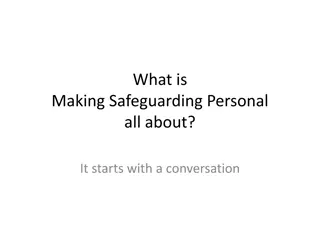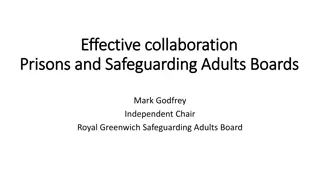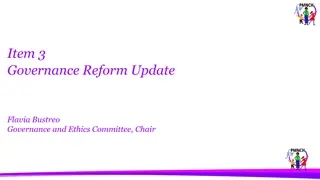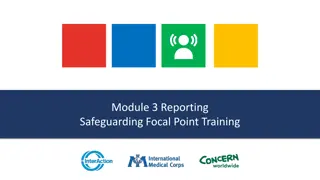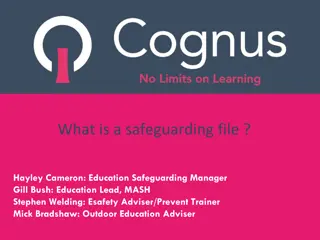
Strategic Governance and Safeguarding Exploration
Explore the strategic role of governance and safeguarding in two sessions focusing on leadership cohesion, regulated frameworks, business tensions, and more. Encourage open discussion, diverse opinions, and awareness of safeguarding frameworks and regulations.
Download Presentation

Please find below an Image/Link to download the presentation.
The content on the website is provided AS IS for your information and personal use only. It may not be sold, licensed, or shared on other websites without obtaining consent from the author. If you encounter any issues during the download, it is possible that the publisher has removed the file from their server.
You are allowed to download the files provided on this website for personal or commercial use, subject to the condition that they are used lawfully. All files are the property of their respective owners.
The content on the website is provided AS IS for your information and personal use only. It may not be sold, licensed, or shared on other websites without obtaining consent from the author.
E N D
Presentation Transcript
Welcome to two sessions exploring the strategic role of governance and safeguarding: Day 1 - An exploration of how governance is cohesively led at senior leadership level - We will explore the role and structure of regulated frameworks - The governance requirements within the frameworks - Expectations re. culture - Resourcing safeguarding - Pulling together key strategic themes approach Day 2 - Tensions between business need , targets and safeguarding - Is your data robust, external view? - Does it safely inform strategy? - Reputational loss and potential links to safeguarding
Each delegate needs to be honest as well as open. Value a diversity of opinions on all topics - different people with different views and opinions. These opinions may clash with each other. Suggestions can then be noted, referred to later or taken away for further consideration Opportunity for everyone for equal participation Be open to new approaches as well as listen to new ideas. Group agreement- safeguarding / strategic governance Na ve questions are useful Balanced participation Anything else you wish to add?
Safeguarding frameworks and legislation- are you all aware of those involved : Spend 5 minutes individually identifying the regulatory and guidance frameworks linked to safeguarding which have to be in place and tested / monitored across your individual service areas. Feedback
Just some of the frameworks and regulations associated with safeguarding Residential special school standards- new in September 2021 KCSIE 2020 next September 2021 Working together 2018/19 Care standards Act 2000 Send 2014 plus amendments re. coronavirus Children s homes regulations 2014 Children s homes standards Schools standards framework SCCIF -social care common inspection framework Ofsted education inspection handbooks Inspecting safeguarding in schools Safer recruitment guidance
Just some of the frameworks and regulations associated with safeguarding Statutory guidance re: admissions/assessment/ behaviour and attendance/curriculum/ early years foundation stage Health and safety legislation- massive! GDPR/ data protection legislation Governance Safeguarding children and young people Coronavirus Act 2020 and amendments 2021 LAC SEN / health needs Safer Other central services legislation .e.g. HR Remote education ( Coronavirus 2021) recruitment/single central register
Just some of the frameworks and regulations associated with safeguarding RE/RSE/HE regulations / curriculum 2019 Behaviour and discipline in schools Training- e.g. team teach , pamova etc with associated regs / guidance Placing regulations and associated other legislation And there are many more including adult safeguarding for young people over the age of eighteen years ..
This exercise shows very clearly: That quality assurance / governance at an operational level can be shaped to the individual settings e.g.. all the legislation / frameworks for schools , residential special schools, children s homes. This, using the particular suite of documents required At a strategic level of governance you have to take on board a wider premise of : ACCOUNTABILITY SITTING WITHIN A ROBUST , WELL INFORMED AND WELL UNDERSTOOD, ORGANISATIONAL SAFEGUARDING CULTURE.
the set of shared attitudes, values, goals, and practices that characterises an institution or organisation the set of values, conventions, or social practices associated with a particular field, activity, or societal characteristic creating a culture of safety means embedding safeguarding into everything an organisation does. Embedding a culture of safety starts at the very top of the organisation with the senior managers pledging absolute commitment and support, including ensuring the resources are available to make it happen. DO YOU RECOGNISE THIS? Culture is key this is a key focus for an external view at senior leadership level.
What is the governance boards strategic role in safeguarding? Protecting people and safeguarding responsibilities should be a governance priority for all organisations. Strategy / board members must take reasonable steps to protect all people who come into contact with the organisation from harm, which is a WIDER duty than just taking care of young people and vulnerable adults. All board/governance members should have at least the level of knowledge equivalent to the staff working in the settings
Thematic approach I have extracted the key themes from the Governance handbook and KCSIE , children s homes standards , residential special schools standards most are common , some are unique, so that we can start pulling a common theme approach together to inform safegaurding at a strategic level. To define primary themes of reporting , secondary themes of reporting, others as required. These to inform strategic safeguarding oversight and accountability
Governance key themes- safeguarding Safeguarding and pupil welfare Allegations of abuse made against other children Allegations made against teachers and other staff Safe recruitment procedures The Prevent Duty Promoting the general wellbeing of pupils School attendance Use of reasonable force Supporting pupils in school with additional health needs School security
KCSIE- key safeguarding themes Safeguarding policies The designated safeguarding lead (DSL) Inter-agency working Staff training Online safety Opportunities to teach safeguarding Allegations of abuse made against teachers, headteachers, principals, volunteers and other staff The child s wishes Looked after children Children with special educational needs and disabilities
Childrens home standards / RSS standards- key safeguarding themes additional to previous slides Children s homes: - Risk assessments - Culture and ethos - The informed child - Policies and procedures - All aspects as captured in previous slides - Regulation 44 Visitor Residential Special Schools - All aspects as captured in previous slides. - Health and safety - Fire - Independent person (monthly) - Independent Visitor ( std 3 from Sept 21.)
Childrens home standards / RSS standards- key safeguarding themes additional to previous slides Children s homes: - Risk assessments - Culture and ethos - The informed child - Policies and procedures - All aspects as captured in previous slides - Regulation 44 Visitor Residential Special Schools - All aspects as captured in previous slides. - Health and safety - Fire - Independent person (monthly) - Independent Visitor ( std 3 from Sept 21.)
Adults safeguarding themes (extra): person centred decision centred-adult led best Interests at the heart of all decisions understanding of mental capacity act and its implications implication of the new liberty safeguards ( code to be published April 2022) other aspects of safeguarding including financial abuse, cuckooing etc Choice leads Role of Deputy - health and welfare and / or finance
Starting points for discussion: Culture- considerations- in place or not? a clear understanding by the group of the common and specific safeguarding issues feeding into strategic safeguarding considerations? a consistent approach across a diverse range of services feeding into strategic safeguarding considerations? roles and responsibilities clear at an operational and strategic level ? can the organisation be held to account? how many people should form a safeguarding board? effective communication in place to inform operational practice? effective dissemination of information in place to inform practice? effective , robust and well informed information ,feeding into the governance safeguarding culture so that secure decisions can be made, plans devised that have the best chance of success and meet strategic safeguarding need?
Culture - constituents and protective features: Leadership Safer recruitment Single Central Record Training / knowledge base for all Accountability Environment/security Covid/ coronavirus response Performance management. Appraisal , supervision Independent visitors audit- Std 20 ,NYAS, Reg.44 Safeguarding as a key thread in the curriculum - RE, RSE, HE, PSHE, specific topics, citizenship etc Code of conduct Policies/processes/procedures Record keeping Focus on vulnerable children those with SEND/looked after children Healthy challenge Whistleblowing RI and nominated individual roles ANY MORE?
Culture: Data- across all services / types Accidents / incidents Interventions Attendance Exclusions Complaints Health and safety ANYTHING ELSE? The VOICE of the child
Kaizen cycle of quality improvement - Continuous improvement -
Let go of assumptions. Be proactive about solving problems. Don't accept the status quo. Let go of perfectionism and take an attitude of iterative, adaptive change. Look for solutions as you find mistakes. Create an environment in which everyone feels empowered to contribute. Don't accept the obvious issue; instead, ask "why" five times to get to the root cause. Cull information and opinions from multiple people. Use creativity to find low-cost, small improvements. Never stop improving. Ten principles Ten principles of Kaizen of Kaizen
Kaizen contd Kaizen is based on the belief that everything can be improved and nothing is status quo. It also rests on a Respect for People principle. Kaizen involves identifying issues and opportunities, creating solutions and rolling them out -- and then cycling through the process again for other issues or problems that were inadequately addressed. These following seven steps create a cycle for continuous improvement and give a systematic method for executing this process. Two key principles below sit well within a strategic view for individuals and the governance board as a whole RESPECT: We respect others, make every effort to understand each other, take responsibility and do our best to build mutual trust. TEAMWORK: We stimulate personal and professional growth, share the opportunities of development and maximize individual and team performance.
Themes going forward : Discuss in small groups across your services common safeguarding themes which would inform an organisational strategic approach feedback
Thinking ahead: - Potential tensions between business need , targets and safeguarding - Is your data robust, external view? - Does it safely inform strategy? - Reputational loss and potential links to safeguarding - We will review these aspects at our next meeting. Thank you.

